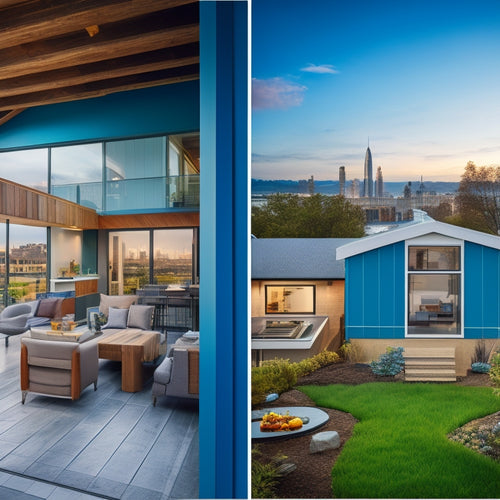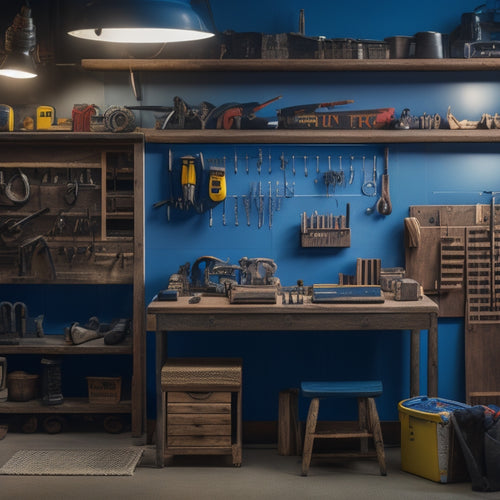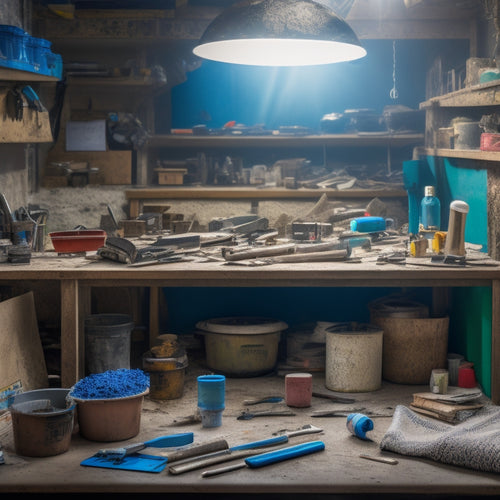
7 Affordable Exterior Wall Covering Ideas for Renovation
Share
You're likely renovating your home's exterior and need affordable wall covering ideas that fit your budget. Vinyl siding is a cost-effective solution that mimics wood or brick, while stucco provides thermal mass and design versatility. Faux brick and manufactured stone veneer offer luxurious aesthetics at lower costs. For a unique look, consider brick pattern options like running bond or herringbone. Exterior insulation and finish improve energy efficiency, and painted concrete block walls provide a rugged texture. Finally, reclaimed wood accent walls add warmth and contrast. Explore these options further to find the perfect blend of style and affordability for your renovation project.
Key Takeaways
• Vinyl siding is a cost-effective solution that mimics wood or brick and requires low maintenance.
• Faux brick and manufactured stone veneer offer luxury aesthetics at a lower cost with minimal maintenance.
• Brick pattern options like running bond, stack bond, and herringbone provide a classic or modern look.
• Exterior insulation and finish systems improve energy efficiency and prevent water damage.
• Painted concrete block walls can add a rugged texture and earthy tones to the exterior facade.
Vinyl Siding for a Budget
When you're on a tight budget, vinyl siding emerges as a cost-effective exterior wall covering solution that can mimic the look of more expensive materials like wood or brick.
With its versatility, vinyl siding can be installed in various profiles, from horizontal to vertical, and in a range of vinyl color options that suit your home's style. From soft pastels to bold statements, you can choose a hue that complements your exterior design.
What's more, vinyl siding is low-maintenance, requiring only occasional cleaning with soap and water to keep it looking its best. Follow these simple vinyl maintenance tips to guarantee your siding remains durable and long-lasting.
Regularly inspect your siding for cracks or damage, and repair them promptly to prevent water seepage. Trim nearby vegetation to prevent scratches, and avoid using harsh chemicals that can damage the vinyl.
Stucco Exterior Wall Finish
Now that you've considered vinyl siding, let's explore stucco as an exterior wall finish option.
You'll appreciate the durability and low maintenance that stucco provides, and its unique texture adds visual interest to your home's exterior.
As you weigh the benefits of stucco, you'll also want to understand the installation process, which involves applying multiple layers of material to create a strong, long-lasting finish.
Benefits of Stucco
With its unique blend of durability, versatility, and aesthetic appeal, stucco exterior wall finishes offer you a multitude of benefits that make it a popular choice among homeowners and builders alike. One of the significant advantages of stucco is its low maintenance requirements. With proper installation and regular upkeep, stucco can last for decades with minimal repairs. Here are some benefits of stucco exterior wall finishes:
| Benefits | Description |
|---|---|
| Durability | Stucco can withstand harsh weather conditions and last for 50-70 years or more. |
| Energy Efficiency | Stucco provides excellent thermal mass, reducing heating and cooling costs. |
| Design Flexibility | Stucco can be molded into various shapes and patterns, offering endless design possibilities. |
| Eco-Friendliness | Eco-friendly stucco options are available, made from natural materials like lime and earth. |
Installation Process
You'll need to prepare the exterior wall surface by cleaning and repairing any cracks or damaged areas before applying the stucco exterior wall finish. This vital step guarantees a strong bond between the stucco and the wall, preventing future cracks and damage.
Surface preparation is key to a successful installation, so take your time to get it right.
Next, you'll apply a layer of wire mesh to the wall, followed by a coat of stucco base. This provides a solid foundation for the final stucco layer.
Here are some essential installation techniques to keep in mind:
-
Apply stucco in thin layers: This allows each layer to dry properly, preventing water accumulation and subsequent damage.
-
Use the right trowel: A sturdy, flat trowel is ideal for applying and smoothing out the stucco.
-
Work in sections: Divide the wall into manageable sections to maintain even coverage and avoid streaks.
Faux Brick Wall Covering
When you choose a faux brick wall covering, you'll have various brick pattern options to select from, allowing you to tailor the look to your exterior design.
As a cost-effective alternative to traditional brick, you'll appreciate the significant savings without compromising on aesthetic appeal.
With a durability guarantee, you can rest assured that your faux brick wall covering will withstand the elements and maintain its visual integrity for years to come.
Brick Pattern Options
Among the numerous faux brick wall covering options, selecting the right brick pattern is vital to achieving an authentic, visually appealing exterior. You'll want to take into account the style, size, and layout of the bricks to create a cohesive look.
When it comes to brick pattern options, you have a range of choices. For a classic look, opt for a running bond pattern, where each row is offset by half a brick. For a more rustic feel, try a stack bond pattern, where bricks are aligned vertically. Or, for a modern twist, take into account a herringbone pattern, where bricks are arranged in a zig-zag design.
Here are three key factors to keep in mind when selecting a brick pattern:
-
Mortar joint styles: Choose from concave, V-joint, or grapevine joints to add texture and visual interest.
-
Color variations: Select from a range of brick colors, from neutral tones to bold hues, to match your home's exterior.
-
Pattern complexity: Take into account the level of complexity you're comfortable with, from simple to intricate, to guarantee a polished finish.
Cost-Effective Alternative
Faux brick wall covering emerges as a cost-effective alternative to traditional brick installation, offering a realistic, high-quality finish at a fraction of the cost and labor. You'll achieve the same classic, timeless look without breaking the bank. This innovative solution uses low-cost materials that mimic the texture and appearance of real brick, making it an ideal choice for budget-friendly designs.
When you opt for faux brick wall covering, you'll notice a significant reduction in installation time and labor costs. The lightweight panels are easy to handle and can be cut to fit around corners, windows, and doors, ensuring a seamless finish.
Plus, they're resistant to weathering, cracking, and fading, ensuring your exterior wall looks great for years to come.
Durability Guarantee
You can rely on faux brick wall covering to withstand harsh weather conditions and maintain its integrity over time, thanks to its durable construction and high-quality materials. This exterior wall covering is designed to provide long-lasting performance, ensuring your home's exterior remains attractive and well-protected from the elements.
One of the key benefits of faux brick wall covering is its exceptional weather resistance. It can withstand:
-
UV rays: Faux brick wall covering is formulated to resist fading and discoloration caused by direct sunlight exposure.
-
Rain and snow: Its water-resistant properties prevent water from penetrating the surface, reducing the risk of damage and moisture-related issues.
-
Extreme temperatures: Faux brick wall covering can expand and contract with temperature fluctuations, ensuring it remains intact and secure.
With minimal maintenance requirements, you can enjoy the benefits of faux brick wall covering without the hassle of frequent upkeep.
This durable exterior wall covering is an excellent choice for homeowners seeking a low-maintenance, high-performance solution for their renovation project.
Affordable Stone Veneer Options
By incorporating manufactured stone veneer into your exterior design, you can achieve a high-end look at a fraction of the cost of natural stone. This cost-effective alternative offers a realistic, textured appearance that mimics the real thing. When selecting a manufactured stone veneer, consider factors such as color, pattern, and texture to guarantee a seamless blend with your home's aesthetic.
To guarantee a successful installation, follow these essential tips: begin by preparing the surface with a waterproof barrier and a layer of scratch coat. Then, apply the veneer, starting from the bottom and working your way up to prevent mortar from dripping onto the already installed stones.
Use a level to guarantee straight lines and a rubber mallet to tap each stone into place. Finally, fill the gaps with mortar, using a color that matches the stones.
With proper installation, your manufactured stone veneer will look like natural stone, but at a fraction of the cost. By following these installation tips, you'll be able to enjoy the luxury of stone without breaking the bank.
Exterior Insulation and Finish
Beyond the visually appealing exterior wall coverings, it's the exterior insulation and finish that play a critical role in regulating your home's temperature and moisture levels. As you're renovating, you'll want to verify that your exterior insulation and finish system is doing its job to keep your home comfortable and energy-efficient.
When it comes to exterior insulation, you'll want to take into account a few key factors to maximize energy efficiency.
Here are three things to keep in mind:
-
R-value: Look for insulation with a high R-value to verify it can withstand extreme temperatures.
-
Moisture management: Choose an insulation system that allows for airflow and moisture evaporation to prevent water damage.
-
Durability: Select insulation that can withstand harsh weather conditions and last for years to come.
Painted Concrete Block Walls
How can painted concrete block walls, with their rugged, textured appearance, be transformed into a visually appealing exterior facade that also provides added protection against the elements?
You can achieve this by selecting the right paint and applying it correctly. Start by power washing the surface to remove dirt and grime.
Then, apply a coat of primer specifically designed for concrete to guarantee a strong bond between the paint and the wall.
When it comes to color selection, consider earthy tones like beige, gray, or brown that complement the natural texture of the concrete. A high-quality exterior latex paint will provide durability and resistance to fading.
For added protection, apply a clear coat of sealant to protect the paint from water and UV damage.
Regular maintenance tips include inspecting the wall for cracks and repairing them promptly, cleaning the wall regularly, and reapplying sealant every few years.
With the right paint and maintenance, your painted concrete block walls can become a stunning and durable exterior feature that enhances your home's curb appeal.
Reclaimed Wood Accent Walls
With a few strategically placed reclaimed wood accent walls, you can inject a touch of rustic charm and warmth into your exterior facade, while also creating a striking visual contrast to surrounding materials like stucco, brick, or siding.
This design element adds depth and character to your home's exterior, making it stand out from the crowd. When sourcing reclaimed wood, opt for sustainable sourcing practices to minimize your environmental footprint.
To guarantee your reclaimed wood accent walls remain stunning for years to come, follow these maintenance tips:
-
Regularly inspect your walls for signs of damage or wear, addressing any issues promptly to prevent further deterioration.
-
Seal or stain your reclaimed wood periodically to protect it from the elements and maintain its rich color.
-
Keep it clean by gently power washing your walls to remove dirt and debris, which can accumulate and cause damage over time.
Frequently Asked Questions
Can Exterior Wall Coverings Be Installed Over Existing Walls?
You're wondering if you can install exterior wall coverings over existing walls. The answer is yes, but it's essential to prepare the surface properly.
Before installation, you'll need to inspect the wall for damage, clean it thoroughly, and make certain it's dry.
Then, you can apply a bonding agent and proceed with your chosen installation technique.
Proper wall preparation is key to a successful and long-lasting exterior wall covering.
Do Exterior Wall Coverings Require Regular Maintenance?
As you initiate this renovation journey, a nagging thought lingers: will your new exterior wall covering become a high-maintenance companion?
The truth is, you'll need to perform regular checks to guarantee its longevity. Maintenance frequency will depend on the material, but generally, you'll need to clean, inspect, and repair every 6-12 months.
Cost considerations will also come into play, as neglecting maintenance can lead to costly repairs down the line.
Stay on top of it, and your exterior wall covering will remain a beautiful, functional shield for your home.
Are Exterior Wall Coverings Resistant to Pests and Rodents?
You're wondering if exterior wall coverings can keep those unwanted critters out, right?
Well, many modern options are designed with pest resistance in mind. Look for materials with built-in rodent barriers, like certain types of insulation or composite panels. These can prevent pests from burrowing in or making themselves at home.
Plus, some exterior wall coverings come with specialized coatings that repel pests. You can rest easy knowing your home's exterior is protected from unwanted visitors.
Can Exterior Wall Coverings Be Used on Curved or Irregular Walls?
When you're dealing with curved surfaces or irregular walls, you'll need to adapt your installation techniques.
You can use flexible exterior wall coverings, like vinyl or PVC, that conform to the wall's shape. Alternatively, you can opt for modular systems that allow for adjustments during installation.
In both cases, precise measurements and careful planning are essential to achieving a seamless look. By choosing the right material and technique, you can beautifully clad even the most complex walls.
Do Exterior Wall Coverings Provide Any Energy Efficiency Benefits?
You're about to uncover a game-changing secret: exterior wall coverings aren't just for aesthetics.
As you're planning your renovation, you're probably wondering if they'll also help you save on energy bills. The answer is yes!
Many exterior wall coverings boast impressive insulation properties, providing a significant boost to your energy savings.
By installing the right covering, you'll be wrapping your home in a warm hug, keeping the heat in and the cold out.
Get ready to cozy up to lower energy costs!
Conclusion
As you step back to admire your renovated exterior, you'll feel like a modern-day Renaissance master, proud of the curb appeal you've crafted on a budget.
Your wallet will thank you, too, since these affordable exterior wall covering ideas have saved you from breaking the bank.
Now, go ahead and take a selfie in front of your revamped facade - the 'gram will be green with envy!
Related Posts
-

Top 3 Insurance Options for Home Renovation
When renovating your home, you need specialized insurance coverage to protect your finances from unexpected setbacks ...
-

7 Smart Tool Organization Tips for Small Renovations
As you tackle your small renovation, you're likely wasting precious time searching for misplaced tools. To enhance ef...
-

Get Discounted Plastering Tool Sets for DIY Renovations
You can find discounted plastering tool sets online, at local hardware stores, and thrift stores, offering a range of...


